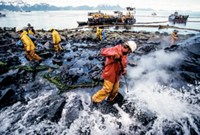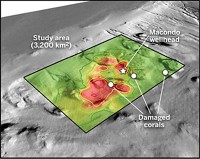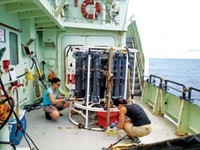Advertisement
Grab your lab coat. Let's get started
Welcome!
Welcome!
Create an account below to get 6 C&EN articles per month, receive newsletters and more - all free.
It seems this is your first time logging in online. Please enter the following information to continue.
As an ACS member you automatically get access to this site. All we need is few more details to create your reading experience.
Not you? Sign in with a different account.
Not you? Sign in with a different account.
ERROR 1
ERROR 1
ERROR 2
ERROR 2
ERROR 2
ERROR 2
ERROR 2
Password and Confirm password must match.
If you have an ACS member number, please enter it here so we can link this account to your membership. (optional)
ERROR 2
ACS values your privacy. By submitting your information, you are gaining access to C&EN and subscribing to our weekly newsletter. We use the information you provide to make your reading experience better, and we will never sell your data to third party members.
Environment
Oil Biodegradation Stalled After Valdez Spill
Oil Spill: Microbes in beach sediments lack the oxygen to finish the job
by Charles Schmidt
September 2, 2010

Twenty-one years ago, the Exxon Valdez spilled 11 million gallons of crude oil into Alaska's Prince Williams Sound. Roughly 1% of that oil still lingers in sub-surface sediments along the coast. Now researchers report that oil-eating bacteria lack the sufficient oxygen to finish cleaning the region's affected beaches (Environ. Sci. Technol., DOI: 10.1021/es102046n).
The scientists studied a 130-foot stretch of rocky beach on Eleanor Island, which was heavily oiled during the spill. Today, the beach's south side is clean, but oil still remains on the north side in a layer roughly one foot below the surface.
Michel Boufadel and Benoit Van Aken, assistant professors of civil and environmental engineering at Temple University in Philadelphia, Pa., wanted to understand why oil degradation differed on the two sides. Microbes need oxygen and nutrients such as nitrogen and phosphorus to efficiently break down oil. So the researchers measured dissolved oxygen, nitrogen, and phosphorus levels in beach sediments by digging 5-foot deep pits and placing sensors and sampling devices just below the oil layer.
After nine weeks, the researchers dug up the sensors and analyzed their data. They found that dissolved oxygen levels barely rose above 1 milligram per liter in the north side's oily sediments, while the clean side's levels reached 5 milligrams per liter. "Aerobic microbes need at least 2 to 3 milligrams per liter of dissolved oxygen to degrade oil efficiently," Boufadel says.
The beach's hydrology is the underlying source of the north versus south differences. Both sides receive oxygenated water from the 15-foot sea tide that flushes the sediments everyday. But fresh water from the shore also recharges sediments in the south side during low tide, Boufadel says. Because of this fresh water, the wet, permeable sediment layer that oxygen-rich water can reach extends to greater depths on the south side than on the north side.
So the north side lags behind the south side in oil degradation, Boufadel says, because oil from the 1989 spill penetrated below the north side's shallow permeable layer and settled into an area that oxygenated water reaches infrequently.
The oxygen data also help explain the failure of some cleanup efforts employed around Prince William Sound, Van Aken says. In the months following the spill, cleanup workers hoped to boost microbial populations and speed the oil's removal on Eleanor Island and elsewhere by fertilizing beaches with nitrogen and phosphorous. But these efforts failed when oxygen levels were not high enough to sustain aerobic biodegredation in the first place.
Jacqueline Michel, president of Research Planning, a consulting firm, in Columbia, S.C., says the study confirms that oxygen availability is the key limiting factor in biodegredation—even in pebble beaches that appear highly permeable. Michel, who is now the National Oceanic and Atmospheric Administration's shoreline clean-up assessment coordinator for the recent Deepwater Horizon spill, thinks that the study's results also suggest that cleanup workers responding to oil spills must identify local limiting factors, such as sediment oxygen and nutrient concentrations, before deciding on a particular cleanup strategy.





Join the conversation
Contact the reporter
Submit a Letter to the Editor for publication
Engage with us on Twitter